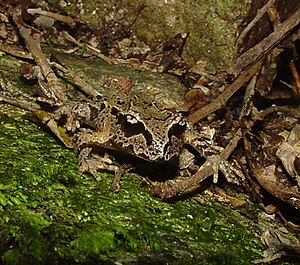Hamilton frog
| Hamilton frog | ||||||||||||
|---|---|---|---|---|---|---|---|---|---|---|---|---|

Hamilton frog ( Leiopelma hamiltoni ) |
||||||||||||
| Systematics | ||||||||||||
|
||||||||||||
| Scientific name | ||||||||||||
| Leiopelma hamiltoni | ||||||||||||
| McCulloch , 1919 |
The Hamilton frog ( Leiopelma hamiltoni ) is a frog from the genus Leiopelma . He is one of the four extant species of primitive family of New Zealand Urfrösche (Leiopelmatidae). It is named after Harold Hamilton, who first collected it. The IUCN classifies the species as "endangered" (endangered).
description
The Hamilton frog is a small species in which the males reach a length of 43 mm and the females reach a length of 49 mm. It is generally dark brown in color with green and light brown spots. The eyes are round, the pupils are unslit and there is no external ear drum. It has no webbed feet and no tail, but atavistic muscles that originally served to move a tail.
Occurrence
The Hamilton frog occurs only in two small places on the mammal-free Stephens Island (New Zealand) in the area of the Marlborough Sounds in the north of the South Island of New Zealand .
Way of life
The Hamilton frog does not go through a tadpole stage, but instead develops completely within a gelatinous egg shell. That is why it does not need standing or flowing water to reproduce. The Hamilton frog lays its eggs under rotten wood or rubble and the male carries the young frogs piggyback to the nearest body of water after they hatch. Hamilton frogs are very dependent on a humid environment. They dry up and die if left in a dry place. Aside from their rarity, the frogs are difficult to spot because they are well camouflaged. They have a nocturnal way of life and don't croak.
Endangerment and resettlement
Due to its limited range, the Hamilton frog is one of the rarest frogs in the world. During the Second World War, a five-year search for this frog remained fruitless and it was not until 1964 that the German animal filmmakers Eugen Schuhmacher and Helmuth Barth succeeded in sighting these frogs for the sixteenth time and making the world's first film recordings, which were shown in the 1967 film The Last Paradises . Until 1992, the Hamilton frog was confined to a 600 m² small scree field in a heavily modified habitat on Stephens Island. Because of the loss of vegetation cover, the habitat was exposed to strong climatic changes. Furthermore, rats had greatly decimated the population in the past. In order to increase the population of around 300 individuals, a new habitat was created between July and October 1991 in a nearby forest remnant, 40 meters from the place of origin, by digging pits and backing up with rubble. A predator-proof fence was erected to keep out the Hamilton frog's greatest natural enemy, the tuatara . Invertebrate prey have been released into the area. Twelve adult frogs were relocated to this area in May 1992. Between 2004 and 2006, 80 Hamilton frogs were released on the island of Nukuwaiata and in 2008 the first baby frogs were discovered there.
Individual evidence
- ^ AmphibiaWeb Leiopelma hamiltoni : Hamilton's Frog
- ^ Chris Mattison: Frogs & Toads of the World . Blandford, London, UK 1992, ISBN 0-7137-2355-6 .
- ↑ Eugen Schuhmacher: The last paradises . Bertelsmann, Gütersloh 1966.
Web links
- Leiopelma hamiltoni inthe IUCN Red List of Threatened Species 2013.1. Submitted by: Mandy Tocher, Derek Brown, Ben Bell, 2004. Retrieved October 24, 2013.
- transfer
- Predation by tuatara (PDF file; 955 kB)
